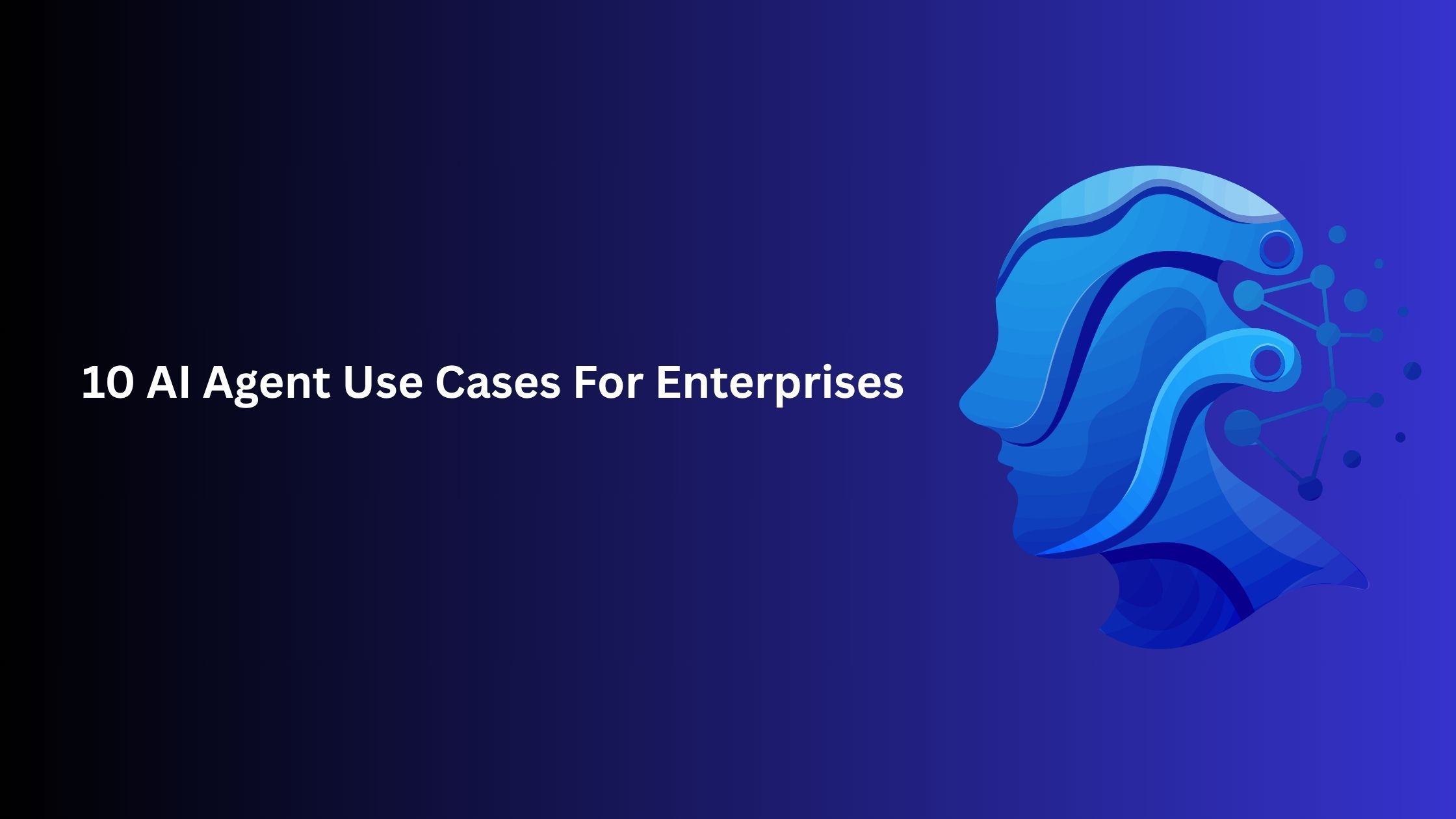10 AI Agent Use Cases For Enterprises

Enterprises are no longer asking “what can AI do?”. They’re asking something way more practical
“How do we use AI to actually move the needle in revenue, speed, efficiency, or competitive edge?”
That’s where these AI agent use cases come in.
In this post, I break down 10 powerful use cases where AI agents are generating revenue, cutting costs, and unlocking entirely new business models for enterprises. We’ll walk you through exactly how these automations work, the tools involved, and how you can bring them to life in your own organization.
Whether you’re leading operations, driving digital transformation, or just tired of hearing “AI” without a clear ROI, this guide is for you.
10 AI Agent Use Cases For Enterprises
These AI agent workflows are easily built on Activepieces.
1. Predictive Maintenance in Manufacturing (Reduced Downtime, Extended Asset Life)
AI-driven maintenance reduces costly unplanned downtime, which directly impacts production output and delivery schedules.
Here is an example of how the flow will work
- Trigger: Webhooks/API Call (from IoT platform/SCADA system): The webhook is triggered when sensor data (temperature, vibration, pressure) indicates an early warning sign of potential equipment degradation.
- Action : AI analyzes the incoming sensor data to predict the specific type and timing of a potential failure based on historical failure data.
- Action( Conditional Logic): If a high-probability failure prediction is identified for a critical asset.
- Action: The AI agent automatically creates a prioritized and detailed maintenance work list, specifying likely causes and recommended actions to prevent revenue-impacting breakdowns.
- Action: A notification is sent to the maintenance team and production managers, including the estimated cost of potential downtime if not addressed promptly.
2. Automated Compliance and Regulatory Monitoring ( Avoid Fines, Protect Reputation, Access New Market)
AI can help enterprises avoid huge fines, legal costs, and damage to their reputation by automatically keeping them compliant with regulations. This means they can continuously follow changing rules and prevent expensive problems from non-compliance. Also, by quickly adapting to new regulations, businesses can access new markets and partnerships, ultimately leading to more revenue.
Here is an example of how the flow will work
- Trigger: Scheduled Daily/Weekly Scan or RSS Feed/Web Scraper Piece: To regularly scrape official legislative databases, legal news portals, and industry-specific regulatory publications for subtle changes or emerging compliance trends.
- Action (AI): AI processes the scraped text and does the following.
- Precisely identify and summarize new regulatory requirements or amendments relevant to the enterprise's specific operations.
- Conduct a gap analysis against current internal policies and procedures (context provided by company policy documents), highlighting areas of non-compliance.
- Assess the severity of potential penalties or business impact for non-compliance.
- Conditional Logic: To check if there are critical compliance gaps or high-risk areas that need to be identified.
- Action: If there are compliance gaps, automatically create a new, high-priority project or task in a project management tool (e.g., Jira, Asana) for the legal and compliance teams, detailing the required policy updates and implementation steps to ensure uninterrupted operations.
- Action: An alert is then sent to the Chief Compliance Officer, legal counsel, and affected department heads, including a risk assessment of potential financial penalties.
3. Energy Management and Optimization (Reduced Operational Costs, Improved Profit Margins)
By projecting future energy needs and costs, enterprises can make more informed purchasing decisions or even participate in demand-response programs, generating additional revenue or avoiding peak pricing surcharges. It also enhances the brand's reputation for sustainability, potentially attracting eco-conscious customers and investors.
Here is an example of how the flow will work
-
- Trigger: Webhooks/IoT Platform Integration receive high-frequency, real-time energy consumption data from smart meters, sub-meters, HVAC systems, lighting controls, and production machinery.
- Action
- AI agent analyzes datasets of consumption patterns against historical benchmarks, external factors (weather, energy market prices), and real-time occupancy.
- AI then generates actionable recommendations for optimizing specific energy loads (e.g., "reduce chiller fan speed by 10% between 2 PM and 4 PM based on current occupancy and external temperature").
- Conditional Logic: To check if significant energy waste patterns are detected
4. Clinical Trial Optimization (Faster Time-to-Market, Reduced R&D Costs)
AI agents help to reduce trial duration, optimize patient recruitment, and minimize costly late-stage failures.
Here is an example of how the flow will work
- Trigger: When a new patient record is added or updated in an Electronic Health Record (EHR) system or a research database, or a new referral is received.
- Action: AI can be used to do the following
- Extract and standardize complex clinical data (diagnoses, comorbidities, lab results, medication history) from unstructured patient notes and structured fields.
- Perform a multi-criteria eligibility assessment against detailed trial protocols, identifying highly suitable candidates and flagging potential exclusion criteria proactively.
- Conditional Logic: To check if a patient meets all key eligibility criteria with high confidence.
- Action: CRM/Clinical Trial Management System (CTMS) creates a new, pre-qualified participant lead in the CTMS, populating all necessary data points to make the enrollment process faster.
- Action: AI notifies the clinical research coordinator about the pre-screened, highly suitable candidate, including a summary of why they qualify, drastically reducing manual screening time and accelerating enrollment.
5. Contract Lifecycle Management (CLM) Automation (Accelerated Deal Closure, Risk Mitigation, Revenue Leakage Prevention)
AI-driven CLM accelerates the entire sales cycle by rapidly generating contracts, leading to faster deal closure and quicker revenue recognition. By identifying and mitigating unfavorable clauses, AI reduces financial risk from disputes, non-compliance, or missed obligations. It also proactively prevents "revenue leakage" by ensuring all earned revenue is recognized and invoicing aligns perfectly with contract terms, maximizing the value extracted from every agreement.
Here is an example of how the flow will work
- Trigger: When a new sales opportunity reaches the "deal won" stage, or a request for a new contract is submitted with initial terms.
- Action: AI agent pulls comprehensive client details, service specifics, pricing models, and agreed-upon terms.
- Action (AI): AI tools are used to
- Generate a first-draft contract based on the pulled data and approved legal templates, ensuring all negotiated terms are accurately reflected.
- Analyze incoming redlines or proposed changes from the client, compare them against standard clauses and risk parameters, and suggest optimal counter-proposals or fallback positions to expedite negotiations while protecting interests.
- Action: The AI agent saves the draft contract to a secure document management system.
- Action: A to-do task is created, and the contract is sent for **internal review and approval, highlighting any AI-flagged high-risk clauses for immediate attention. The flow does not continue until an approval is given
- Action: Once all internal approvals are secured, the contract is sent via an e-signature platform (e.g., DocuSign, Adobe Sign), reducing signature delays and accelerating revenue recognition.
6. Real Estate Portfolio Optimization (Maximized Asset Value, Optimized Yields, Informed Investment Decisions)
AI-driven optimization directly maximizes the value and yield of real estate assets by identifying optimal acquisition times, dynamic pricing strategies, and proactive maintenance needs. This enables investors to make more profitable allocation decisions, avoid underperforming assets, and identify lucrative new opportunities, leading to increased portfolio ROI.
Flow:
- Trigger: Scheduled Daily/Weekly
- Action: Web scraper/API calls collect real-time and historical data from:
- Multiple real estate listing and sales platforms ( property attributes, prices, transaction history).
- Economic data APIs (inflation, interest rates, employment figures, GDP by region).
- Local government and urban planning APIs (zoning changes, new development permits).
- News APIs (major corporate relocations, infrastructure projects).
- Internal portfolio data (current occupancy rates, rent collection status, maintenance costs, tenant demographics).
- Action (AI): AI is used to
- Perform predictive analytics to forecast future property valuations, rental rates, and occupancy levels based on a comprehensive set of internal and external factors.
- Identify underperforming assets within the portfolio and recommend specific optimization strategies (e.g., renovation, rent adjustment, divestiture).
- Action: ****AI agent stores the data, processed insights, and quantified investment recommendations in a centralized real estate intelligence database.
- Action: Weekly market summaries and alerts for high-value opportunities are sent to stakeholders, enabling prompt, informed investment decisions that drive revenue and minimize losses.
7. Environmental, Social, and Governance (ESG) Reporting Automation (Enhanced Investor Confidence, Access to Capital, Reduced Regulatory Risk)
Automating ESG reporting with AI agents builds stronger investor confidence by providing accurate, transparent, and timely sustainability data, which can lead to preferential financing rates and increased capital inflows from ESG-focused investors. It significantly reduces the manual effort and cost of complex reporting, minimizes errors that could lead to non-compliance fines, and enhances brand reputation, which can attract customers and talent
Here is an example of how the flow will work
- Trigger: Scheduled Monthly/Quarterly
- Action: The AI agent pulls diverse data from internal and external systems:
- Action (AI): AI is used to do the following
- Validate and categorize data points according to chosen ESG frameworks (e.g., GRI, SASB, TCFD).
- Identify any data gaps, inconsistencies, or potential signals that could undermine reporting credibility.
- Draft narrative sections for the ESG report, summarizing performance against targets and highlighting key achievements, demonstrating positive impact for investors.
- Perform peer benchmarking to show how the company performs relative to competitors.
- Action: AI agents automatically populate the database with auditable and investor-ready data.
- Action: The draft report is sent to the sustainability team, legal, and executive leadership for review, emphasizing areas of strong performance or identified risks.
8. Knowledge Management and Retrieval (Increased Productivity, Faster Problem Solving, Reduced Support Costs)
An intelligent knowledge management system helps employees by letting them find information faster, so they can spend more time on tasks that make money. It also helps them solve problems quicker, which means faster projects and happier customers. Since the system can handle common information requests, businesses can save a lot on support costs, which boosts profits.
Here is an example of how the flow will work
Part 1: Intelligent Knowledge Ingestion:
- Trigger: When a new piece of organizational knowledge is added to any company system.
- Action (AI): AI does the following
- Summarization of the content, identifying key concepts, and actionable takeaways.
- Extracts all relevant entities (people, projects, products, systems, dates) and automatically tags and categorizes the content
- Action: ****AI agents store the summarized, richly tagged, and categorized content in an internal knowledge base system (e.g., Notion, Confluence, custom enterprise KB), ensuring it is easily searchable.
Part 2: AI-Powered Query Handling
- Trigger: An employee, sales rep, or support agent queries the knowledge base via a chat interface (e.g., "How do I troubleshoot X product issue for a customer?", "What's the latest competitive analysis on Y?").
- Action (AI): AI interprets the natural language query with high accuracy
- Action: AI agents find the most relevant and up-to-date documents, prioritizing authoritative sources.
- Action: Chatbot presents the accurate answer to the employee, reducing resolution time for customer issues, accelerating sales cycles by providing quick info, and minimizing internal friction points that cost time and money.
9. Workforce Planning (Optimized Talent Allocation, Reduced Recruitment Costs, Higher Productivity)
AI-driven workforce planning enables enterprises to proactively align talent with business goals, ensuring the right skills are available when and where needed. This reduces costly delays in project execution due to skill shortages, minimizes expensive external recruitment for roles that could be filled internally, and boosts overall workforce productivity by optimizing talent allocation and development.
Here is an example of how the flow will work
- Trigger: Scheduled Monthly/Quarterly
- Action: The following data is pulled:
- Current employee skills, certifications, and experience (from HRIS, performance reviews).
- Future project demands and strategic initiatives (from project management tools, and strategic planning documents).
- Recruitment pipeline status and time-to-hire metrics (from ATS).
- Employee turnover rates and trends.
- Training completion and skill development programs.
- External market data on talent availability and compensation.
- Action (AI): Then, AI does the following
- Perform a dynamic skill gap analysis, comparing current workforce capabilities against projected future needs for critical roles and emerging technologies.
- Identify internal talent pools that can be re-skilled or upskilled for future roles, reducing external hiring costs.
- Recommend optimized talent acquisition strategies
- Action: AI updates a real-time workforce planning dashboard with actionable insights, detailed skill gap visualizations, and quantifiable talent strategies, enabling data-driven decision-making for HR and executive leadership.
- Action: Comprehensive summaries are sent to HR leadership, finance, and department heads, outlining projected talent needs, associated costs, and potential revenue impact of strategic talent decisions.
- Action: Specific tasks for HR teams are created based on identified talent needs (e.g., "design new AI/ML training program for 100 employees," "launch internal mobility campaign for sales roles"), ensuring timely execution of revenue-enabling talent strategies.
10. Product Design and Prototyping Acceleration (Revenue Driver: Faster Time-to-Market, Reduced Development Costs, Higher Product Success Rate)
AI agents in product design help companies launch new products much faster. They automate design changes and find the best materials. This significantly cuts down on development time.
Here is an example of how the flow will work
- Trigger: ****A new product concept is approved, or an existing product undergoes a major revision
- Action: The AI agent pulls product specifications, desired performance metrics, target manufacturing costs, material constraints, and market segment data.
- Action (AI): An AI tool is then used to generate hundreds of diverse design iterations based on specified parameters
- Action: All generated simulation results and material recommendations are saved and linked to the original product brief.
- Action: AI notifies the product design and engineering teams with the top AI-generated design concepts, highlighting their predicted performance, cost benefits, and time-to-market advantages, enabling faster decision-making and reduced iteration cycles
Ready to Build AI Agents That Actually Work for Your Business?
With Activepieces, even non-technical teams can build and launch these workflows, no code, no engineering bottlenecks.
Sign up for a free account and start automating in minutes: https://www.activepieces.com/


